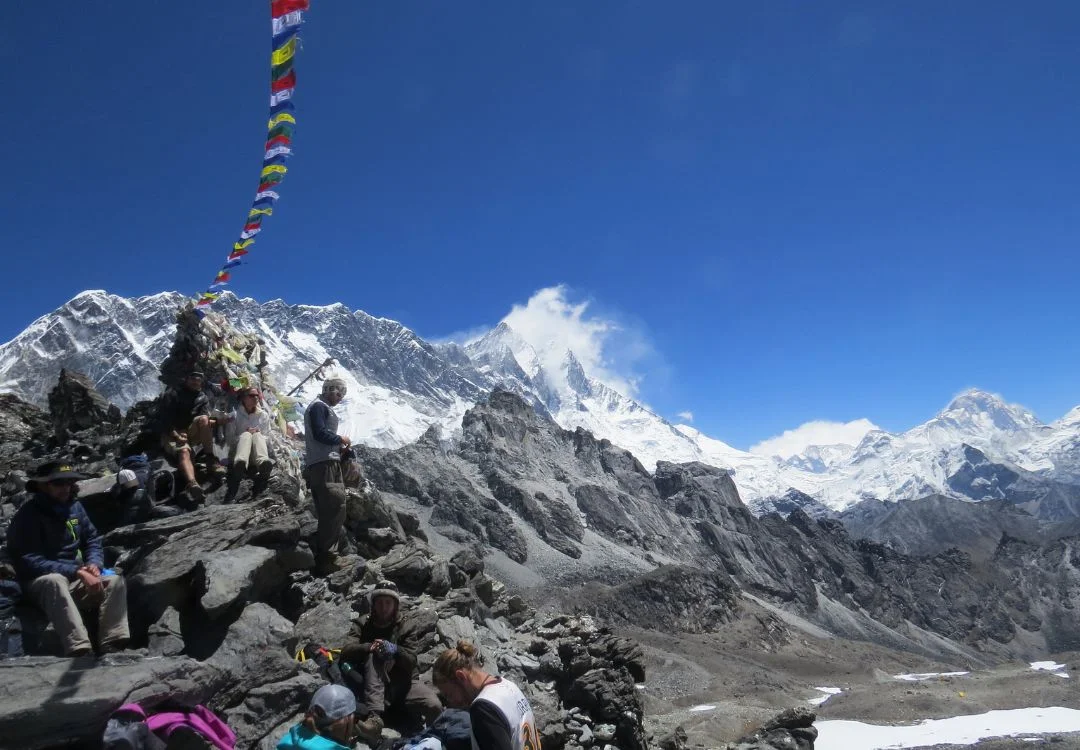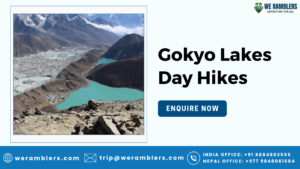Rescue During Three Passes Trek: Your Lifeline Across Nepal’s Highest Passes
The Three Passes Trek is widely regarded as the most comprehensive and challenging route in the Everest region. Covering over 160 kilometers and three high-altitude passes— Kongma La (5,535m), Cho La (5,420m), and Renjo La (5,340m) —this trek pushes both body and spirit. It offers an immersive Himalayan experience, weaving through iconic stops like Everest Base Camp, Gokyo Lakes, and Namche Bazaar.
However, the grandeur comes at a cost. Thin air, extreme cold, isolated terrains, and sharp elevation gains often lead to physical and medical challenges. Trekkers are at risk of AMS, frostbite, and injuries, especially when fatigue sets in at higher altitudes. In these scenarios, rescue during Three Passes Trek becomes a vital intervention that can mean the difference between a safe return and a life-threatening delay.
High-Risk Situations: What Can Go Wrong During the Three Passes Trek?
While the trek promises unmatched views and personal achievement, the environment can quickly turn hostile. Understanding the kinds of emergencies trekkers face is the first step toward responsible adventure.
1. Altitude-Related Health Issues
The most common risk is Acute Mountain Sickness (AMS). As you ascend above 3,000m, oxygen levels drop by over 40%, affecting breathing, sleep, and energy levels. Severe cases may develop into HAPE (High-Altitude Pulmonary Edema) or HACE (Cerebral Edema)—both requiring Altitude Sickness Rescue in Everest Region to prevent fatal outcomes.
2. Injuries on Rugged Terrain
The trails between passes, especially Cho La, are often icy, rocky, and steep. Falls, twisted ankles, dislocations, and fractures are not uncommon. With medical facilities days away, rescue from Three Passes Region is the only viable solution.
3. Exhaustion and Dehydration
Due to the lack of oxygen and strenuous climbs, trekkers may experience chronic fatigue or dehydration, impairing decision-making and motor control. Symptoms may mimic severe illness, requiring emergency evaluation.
4. Severe Weather Events
High-altitude regions are prone to sudden snowstorms, avalanches, and extreme cold. Poor visibility and frostbite risks often necessitate emergency evac service in Everest Region, especially in winter and shoulder seasons.
Air Evacuations: How Helicopter Rescues Work in the Everest Region
When foot-based evacuation isn’t feasible, Helicopter Rescue from Three Passes Trek becomes the safest and fastest option. However, executing an airlift at altitudes above 5,000m is a highly coordinated effort involving multiple stakeholders.
Step-by-Step Process of Air Rescue:
- Emergency Notification: The trekker or guide contacts the operations team via satellite phone or radio.
- Medical Triage: A trained staff member assesses symptoms, altitude, and urgency.
- Coordination: We liaise with licensed helicopter companies, TAAN, and insurance providers to initiate the airlift.
- Pickup: The helicopter rescue from Three Passes package covers landing at accessible zones like Dzongla, Lobuche, or Gokyo.
- Hospital Transfer: Patients are flown directly to Kathmandu hospitals such as CIWEC Clinic or Norvic International.
Challenges with Helicopter Landings:
- Altitude and terrain limit viable landing spots.
- Poor weather, especially snow or fog, may delay flights.
- Costs rise steeply due to difficult altitude and remote pick-up points.
That’s why the rescue team pre-identifies safe evacuation zones during route planning, ensuring quick response when needed.
Understanding Costs of Rescue During Three Passes Trek and the Role of Travel Insurance
High-altitude evacuations are not cheap. A Three Passes Trek rescue cost ranges between $3,500–$6,000, depending on distance and urgency. Hence, travel insurance for Three Passes Trek rescue isn’t optional, it’s mandatory.
Why You Need High-Altitude Insurance:
- Regular insurance rarely covers trekking above 4,000m.
- Coverage must include helicopter evacuation, emergency medical, and trip cancellation.
- Top insurers like World Nomads, Global Rescue, and IMG offer reliable Himalayan packages.
Insurance Claim Process:
- Post-rescue, trekkers must submit a full incident report, invoices, medical diagnosis, and proof of insured activity.
- We Ramblers helps gather and submit this documentation, streamlining claim processing.
If your insurance is denied or coverage is invalid, the rescue operation is still initiated, but payment becomes your responsibility. We Ramblers may provide assistance with temporary financial coordination if needed.

We Ramblers’ Rescue Strategy
At We Ramblers, we’ve designed a multi-layered safety system for treks like Three Passes, ensuring rapid intervention in any crisis.
Our Safety Measures Include:
- 24/7 Emergency Operations Desk: Trained personnel monitor your movement using check-ins and GPS systems.
- Wilderness First Responders (WFR): Every guide is certified in emergency medicine, trauma care, and AMS recognition.
- On-Trek Medical Gear: Every group carries portable oxygen cylinders, pulse oximeters, and first-aid kits.
- Tech-Enabled Contact: Use of satellite phones and radio relays ensures communication even in deep valleys.
- Strategic Helicopter Partnerships: We maintain direct lines with leading Everest region trekking evacuation pilots and companies.
Through every pass and peril, we stand as your dedicated emergency response partner, quietly watching, always ready.
How We Collaborate with Authorities and Local Teams
Emergency rescues in Nepal involve far more than helicopters and guides. Legal and operational coordination with multiple agencies ensures safe, ethical evacuations.
Here’s how we handle rescue logistics:
- TAAN (Trekking Agencies’ Association of Nepal): Manages documentation and official permissions.
- Nepal Police and Army Posts: Provide airspace clearance, logistics help, and sometimes ground support.
- Local Guides and Porters: Assist in carrying injured trekkers to safer extraction points.
- District Health and Tourism Authorities: Validate medical conditions for airlift justification.
All these stakeholders work in sync with the We Ramblers team to maintain transparency, legality, and promptness throughout the rescue from Three Passes region.
Preventive Trekking: How to Stay Out of the Rescue Zone
While we are prepared for every emergency, we believe that prevention is the best strategy. A few smart habits can significantly reduce your chances of needing evacuation.
Tips to Trek Safely:
- Acclimatize Generously: Include extra rest days in Namche, Dingboche, and Gokyo.
- Hydration Discipline: Drink at least 4 liters of fluid daily, even when it’s cold.
- Watch Your Pace: Never rush uphill; let your heart rate and breath guide you.
- Listen to Your Body: Report any symptoms of AMS early.
- Train Before You Trek: Build cardio stamina, leg strength, and endurance with at least 6 weeks of pre-trek conditioning.
- Avoid Alcohol and Smoking: Especially above 3,000m.
- Be Honest: Share past health issues and medications with your guide.
Smart preparation means fewer surprises, and more time to enjoy the stunning Himalayan landscapes.
FAQs About Rescue During Three Passes Trek
Q1: Is helicopter evacuation always possible?
A: No. Rescues depend on weather, terrain, and altitude. If helicopters can’t land, ground evacuation will be organized.
Q2: What happens after evacuation?
A: You’re flown to Kathmandu, where hospital care and insurance processing begin. Our team handles all logistics.
Q3: Do I get a refund for the rest of my trek?
A: Trek refunds vary by situation. We provide full reports to help you claim remaining insurance amounts.
Q4: Who covers the cost if I didn’t declare a health condition?
A: Insurance may reject your claim. In that case, you’re responsible for costs.
Q5: Can I rejoin the trek later?
A: Based on medical clearance, We Ramblers can organize a partial route or alternate trek.
Adventure with Assurance
The Three Passes Trek is an exhilarating journey, but also a serious expedition that demands preparation, responsibility, and a reliable partner. Emergencies can happen, but with We Ramblers, you’re never alone. Whether it’s a sudden illness or unforeseen weather, we activate a robust network of rescue teams, medical staff, and local authorities to bring you home safely.S
o go ahead—embrace the mountains, cross those icy passes, and marvel at Everest. Just remember to trek smart, trek safe, and always trek with We Ramblers. Contact us now for more details.





